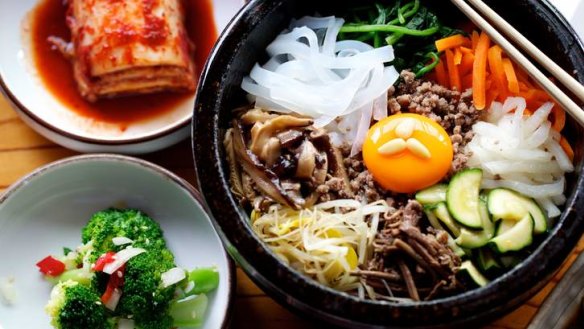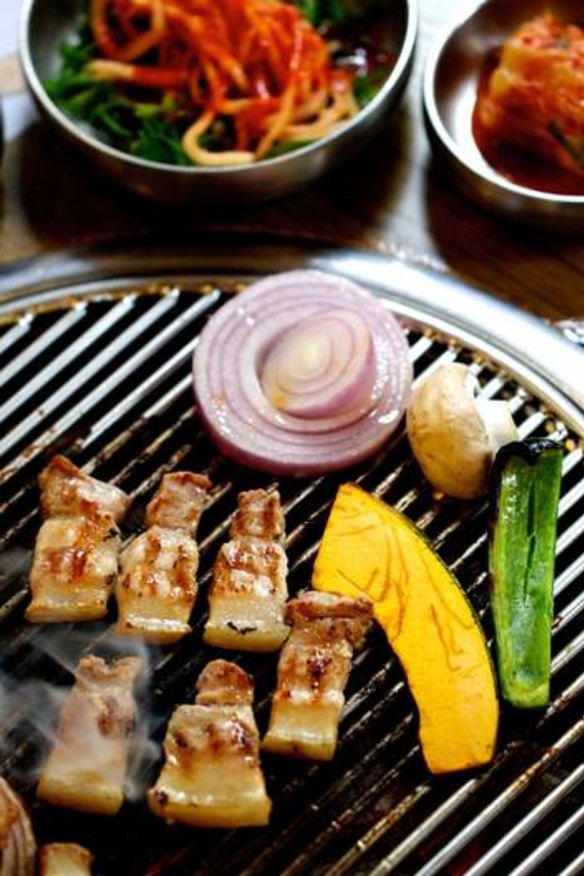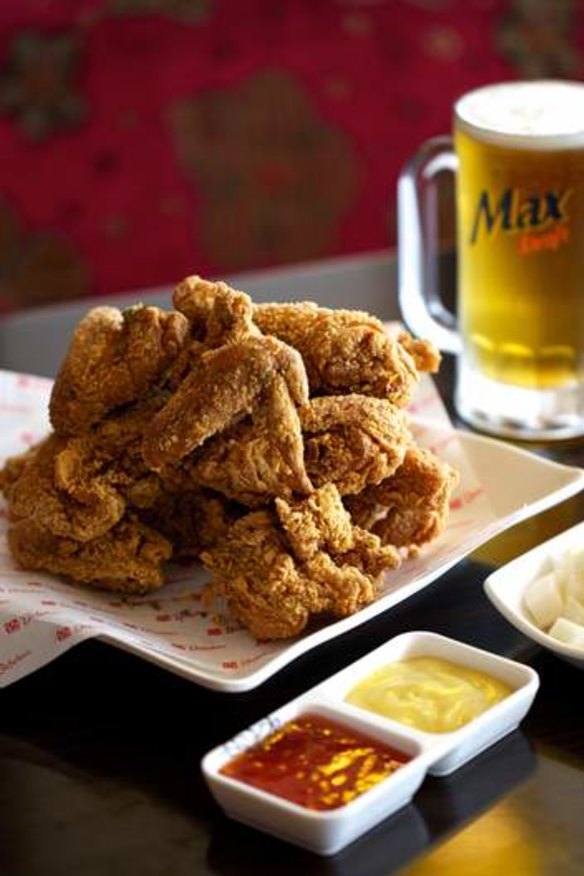Sydney's must-try Korean dishes
Korean fried chicken is a hit addition to Seoul food. But there are lots of tastes to try at Sydney's best Korean restaurants, from bibimbap to bossam. Here's where to find them.

From the smear of ssamjang sauce on Peter Gilmore's wagyu dish at Quay, to the pile of kimchi accompanying Jared Ingersoll's meat platter at his pop-up, Bottle and Beast, the signs of Korean influence in Sydney's most stellar kitchens are rapidly multiplying.
For the past couple of years, food trend forecasters have labelled Korean cuisine as the next big thing.
On the world stage there has been plenty to fuel this. Last year, two Michelin stars were bestowed on an all-out Korean restaurant for the first time -a fine-diner called Jungsik in Manhattan. And Korean tapas bar Danji, also in Manhattan, has held onto its single star since 2012.
And then there's David Chang, the Korean-American "pork-happy, pickle-loving individualistic'' chef, as The New York Times put it. He created the Momofuku empire and has done much to glamorise elements of the cuisine with his cult-like status in the restaurant world.
Korean is, of course, not new to Sydney. It arrived with the first waves of immigrants, starting largely in the '70s. Today there are more than 100 havens feeding mostly Korean locals in community hubs such as Eastwood, Strathfield, Lidcombe, Campsie and the CBD.

In the past year though, Sydney has welcomed a posse of Korean restaurants spruiking classic dishes with a modern flair. There's the elegant Moon Park headed by ex-Claude chefs Ben Sears and Eun Hee An, and the casual diner Seoul Food in Surry Hills. And Danjee in the city is doing Korean barbecue washed down with a fascinating modern wine list.
After years of eating Chinese, Thai and Vietnamese, Australians - with palates increasingly used to Asian flavours - are searching for more, says David Ralph of the new Kim Restaurant in Potts Point. "We're ready not only to try Korean food, but different interpretations of it," he says. "It's an honest cuisine, it doesn't hide anything. It looks simple and easy but once you start getting into those depths and flavours and layers there's a lot going on," he says.
Peter Gilmore says his experiments with Korean ingredients became serious about three years ago. Last week he added a quail dish to the menu, where the meat has been rubbed in virgin black sesame oil, imported from Korea.

He will not call Korean food an impending trend though. ''The influences are part of our fabric - the experience of food in multi-cultural Australia.''
Jared Ingersoll appreciates the wholesomeness of traditional Korean food. Korea's flagship dish kimchi, which he adds to the charcuterie platter at his pop-up Bottle and Beast, deploys a huge amount of beneficial bacteria to the gut.
“I first tried it 10 years ago, and I was confronted. It was fizzy, but so delicious. It freaked me out,” he says. “It’s the really sharp stringent crunchiness that I love.”
Here's a list of six, must-try dishes with restaurant recommendations that will take you into the heart of Sydney's Korean communities. We've aimed for a mix of eateries, from ones that offer modern twists to those remaining faithful to traditional recipes.
Bibimbap
If Korea were to be summed up in a bowl, bibimbap would be the most likely contender. This one-bowl wonder usually consists of warm rice topped with five or more clusters of sauteed vegetables, fried egg and cooked beef. "Bibim" means to mix, so don't hesitate to stir up all the ingredients as soon as the dish arrives. Add gochujang, the famed chilli paste, to the desired level of spiciness.
Bibimbap is often prepared and served in a blisteringly hot stone pot called a dolsot, which warms it for the length of the meal. Try it at the cosy, corner tuckshop Bibim, to Mix (169 William Street, Darlinghurst). "We cook it exactly as we would have it at home," says Piljae Yi, who always offers to mix the dish at the table. "In a dolsot, the rice turns crispy, adding texture, and the sauce becomes richer, changing the flavours entirely."
For a modern-twist on this favourite, order bibimbap from the restrained but refined menu at Moon Park (34 Redfern Street, Redfern). The ex-Claude's chefs have added barley to the rice, used cured egg shavings, and slid in sweet corn, crab meat, dried seaweed and spring onion. Outright unusual, but delicious nonetheless.
Mul Naengmyeon
The English translation - cold noodles in watery broth - isn't exactly endearing, but don't let that stop you. It's one of the most popular noodle dishes in Korea. In a stainless-steel bowl you'll see half a boiled egg and julienned cucumber, radish and Asian pear balanced on a mound of darkish noodles sitting in tangy iced broth. The ice will melt rapidly as dashes of vinegar and mustard oil are stirred in.
Seung-Yone Park from Poong Nab Dong (205 Rowe Street, Eastwood) spends up to 10 hours each week preparing the broth. She seasons it with beef, onion, shallot roots and a variety of other ingredients to hit the unique flavour notes. Arrowroot noodles are used in the four variations of naengmyeon at the family-friendly eatery. "There are nutritional benefits and it helps with better digestion," she says.
The more common noodle alternative is the lighter-coloured buckwheat, as seen at HanYang Galbi (28/45-47 The Boulevarde, Strathfield). They insert a slice of tomato in their mul naengmyeon to sweeten the dish. Both restaurants do barbecue, so why not enjoy grilled meat while intermittently slurping on the cold broth to cleanse the palate?
Bossam
"Ssam" means to wrap, so get ready to package each bite. Bossam is typically sold as a share platter for two to four people priced at about $30. You'll be presented with numerous, bite-sized pieces of boiled pork belly, a spicy clump of pickled radish strips and oysters, wafer-thin sheets of vinegar-soaked radish and rice. Wrap these in lettuce and sesame leaves and chow down. Maybe add a smear of ssamjang sauce to the next wrap, or kimchi. Experiment and have fun.
David Ralph and Tae Kyu Lee, co-owners and co-chefs of the newly minted Kim Restaurant (7/24-30 Springfield Avenue, via Llankelly Place, Potts Point) are offering a contemporary, edgy take on the share dish. They half-steam and half-braise Bangalow pork belly, to retain as much of the fatty, juicy goodness as possible. Their nutty homemade ssamjang is divine, and they've chosen baby cos lettuce for the wrap.
For a more old-school experience, hotfoot it to the bustling Maroo Korean Barbecue Restaurant (16 Church Street Ryde) where succulent meat is served with salt-soaked cabbage. Since you're sharing bossam, why not also share a jjigae? The complimentary bowl of pumpkin soup to start will tease your tastebuds before an order is even taken.
Korean fried chicken
It's the KFC that is on everyone's lips - Korean fried chicken, that is. When done right, the pieces are crispy without being greasy, light but not dry, tasty without having to be saucy. It's not traditional fare, but fried chicken is a food trend of phenomenal proportions in South Korea. A platter of chicken pieces is usually devoured as a late-night snack, washed down with a Korean beer - OB, Max, Hite. A refillable bowl of radish cubes drenched in vinegar is the standard accompaniment. The correct method involves frying lightly battered pieces twice, at different temperatures.
There's been an eruption of Korean fried chicken specialists all over Sydney, from Red Pepper (4A Lyons Street, Strathfield) in a sports club, to the Korean watering-hole Gallus Gallus (76A Archer Street, Chatswood), to Jeans Chilli Chicken (115 Rowe Street, Eastwood) which spruiks the healthy-sounding ginseng fried chicken. The crown for the best fried chicken however remains up for grabs.
Beschico (2/41 Beecroft Road, Epping) is a good starting point. Try their crispy original, and follow up with the ever-popular garlic soy sauce flavoured chicken. And by "whole", they mean 14 pieces.
Samgyeopsal
The cook-it-yourself Korean barbecue journey is never complete without a large serving of non-marinated strips of fatty pork belly. Koreans enjoy sitting around a grill and cooking the meat until it's sizzling and crispy. The glistening pieces of gold can be placed on top a spoonful of rice and kimchi, or, like bossam, wrapped with various elements on the table in leafy greens, and eaten with ssamjang sauce.
For the uninitiated, the samgyeopsal smorgasbord can turn dining into a daunting experience. The staff at 678 (1/ 396 Pitt Street Sydney) offer grilling tips and red mini aprons to protect your clothes. You won't find samgyeopsal, meaning "three layers of flesh", on its menu, because they instead offer the premium ''ohgyeopsal'', meaning five layers. "The strips are fattier and juicier. It's our most popular item," says general manager Michelle Bu. Most people ''love the fattiness in the pork belly because of the taste".
In Strathfield's Korean community hub, enter the bustling Jang Ta Bal (48A The Boulevarde Strathfield), nab a low table and sit on pillows on the floor for an experience with a traditional tilt.
Sundubu Jjigae
Like bibimbap, it's a safe bet that every Korean restaurant serves up this spicy soup of uncurdled soft tofu, vegetables and seafood. Expect to see a raw egg cooking at the centre of a furiously bubbling red brew when it arrives. Sundubu jjigae is always served with rice, so enjoy it together with the banchan. The chilli level is usually high, but waiters are accustomed to requests for it to be turned down a notch.
You'll see sundubu jjigae on almost every Korean restaurant menu. But sundubu jjigae specialist BCD Tofu House (10/74 Rawson Street, Epping), offers 13 spins on the classic brew. Whether you choose the kimchi version or the dumplings, the soft tofu in chilli broth combo remains as the base. "The seafood sundubu jjigae is the best-seller," says owner Thomas Park. Make sure to crack and spill the egg into the soup as soon as it arrives.
The small and modest Eunhasu (37 Everton Road, Strathfield) cooks all the Korean classics well, and doesn't fail to impress with their sundubu jjigae. It's boiling hot on arrival and accompanied by a bowl of purple rice, coloured by iron-packed, rich-in-antioxidant granules of black rice.
Know your Korean
Bap - Cooked rice and other grains.
Doenjang - A pungent brown paste made with fermented soybeans.
Dubu - Korean tofu.
Gochujang - A thick, red paste made with chillies.
Jjigae - A stew with vegetables, meat and tofu, in a broth usually flavoured with gochujang or doenjang.
Jorim - Vegetables, meat and tofu simmered in a seasoned broth.
Kimchi - Spicy or sour fermented vegetables, such as napa cabbage and radish.
Namul - Lightly cooked and seasoned vegetables, such as spinach and bean sprouts.
Ssam - To be wrapped, usually in leafy greens.
Ssamjang - A mixture of doenjang and gochujang pastes, used in wraps.
Special thanks to Jina Hong, Alex Lee, Heather Jeong, Jenna Yoon and Sunny Lim.
Restaurant reviews, news and the hottest openings served to your inbox.
Sign up